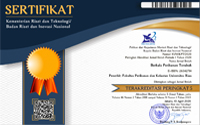IDENTIFICATION OF CHLOROPHYLL-A DISTRIBUTION FOR POTENTIAL FISHING ZONE BASED ON INTERPRETATION LANDSAT 8 IMAGERY IN KENDAL WATERS CENTRAL JAVA
Abstract
Keywords
Full Text:
PDFReferences
Apriliani, F.K, (2014). Analisis Potensi Lokal di Wilayah Pesisir Kabupaten Kendal Dalam Upaya Mewujudkan Blue Economy. Economic Development Analysis Juornal Unnes.Vol (3) No.1.
Badan Pusat Statistik (2018). Kabupaten Kendal Dalam Angka. Penerbit BPS Kendal.
Cahyono, B. (2010). Proses Pengolahan Data Citra Modis untuk Menduga Konsentrasi Klorofil-a Sebagai Indikator Tingkat Kesuburan di Perairan Utara Papua. Laporan Praktek Kerja Lapangan Fakultas Perikanan dan Ilmu Kelautan Universitas Diponegoro. Semarang.
Departemen Kelautan dan Perikanan. (2006.) Panduan Jenis-jenis Penangkap Ikan Ramah Lingkungan. Jakarta: Bina Marina Nusantara.
Dahuri, R., Rais, J.,Ginting, SP.,Sitepu, MJ. (2008). Pengelolaan Sumber Daya Wilayah Pesisir dan Lautan Secara Terpadu. Jakarta, Pradnya Paramita.
Fausan. 2011. Pemetaan Daerah Potensial Penangkapan Ikan Cakalang (Katsuwonus Pelamis) Berbasis Sistem Informasi Geografis di perairan Teluk Tomini Provinsi Gorontalo. Skripsi Jurusan Perikanan Universitas Hasanuddin. Makassar.
LAPAN, (2015). Pedoman Pembuatan Informasi Spasial Zona Potensi Penangkapan Ikan Berbasis Data Satelit Penginderaan Jauh. Jakarta. Pusfatja LAPAN.
Maslukah, L, Wulandari, S.Y. & Prasetyawan, I.B.(2016). Kontribusi nutrien N dan P dari sungai Serang dan Wiso ke perairan Jepara. Prosiding seminar nasional hasil-hasil penelitian perikanan dan kelautan ke-VI. Fakultas Perikanan dan Ilmu Kelautan – Pusat Kajian Mitigasi Bencana dan Rehabilitasi Pesisir, Undip. pp :183-191
Nontji, Anugerah. (2008). Plankton Laut. Yayasan Obor Indonesia. Jakarta.
Purwadhi, S.H. (2001). Interpretasi Citra Digital. Jakarta: Grasindo
Syetiawan, A. (2015). Penentuan Zona Potensi Penangkapan Ikan Berdasarkan Sebaran Klorofil-a. Jurnal Ilmiah Geomatika Badan Informasi Geospasial. Vol (21) No2. , 131-136
Wibowo, A. Sumartono, B. Setyantini, W,H. Populus, J. 1994. The application of satellite data improvement site selection and monitoring shrimp pond culture case study on Cirebon, Lampung, Jambi, and Jepara Coasts. In Remote Sensing and Geographic Information System. BPPT. Jakarta. h16-27
DOI: http://dx.doi.org/10.31258/terubuk.48.1.287-297
Refbacks
- There are currently no refbacks.
Copyright (c) 2020 Thonas Indra Maryanto, Anti Febriyanti

This work is licensed under a Creative Commons Attribution 4.0 International License.












